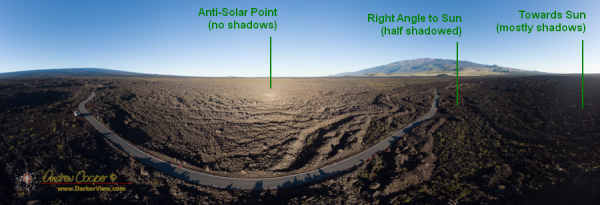I have run into a significant problem I did not expect.

Even better, I need only stop off on the way to or from work at the summit to find time to fly here. Leave for work early, discharge a few flight batteries, join the rest of the crew for breakfast at Hale Pōhaku.
Just after dawn or just before sunset the light accentuates this dramatic landscape, intensifying the colors, the low sunlight angle creating shadows that reveals the stark terrain.
The low sunlight angle causes some problems as well. One I expected… The drone camera does not deal well with glare. Take an image pointing near the Sun and the image is often ruined by the glare. This is discussed in some of the review videos I watched before I bought the drone. Easy to avoid, just point away from the Sun before you start that panorama sequence.
The second major issue I did not expect… Many of the images feature a very bright spot directly opposite the Sun in the sky. This spot is intense, creating a peculiar feature in the photograph that I find distracting.
I am well acquainted with the reasons for this bright spot, I have even posted on the effect here on DarkerView previously. Called the opposition effect which can result in a brightening seen directly opposite the light source, usually the Sun.
The effect can be caused by retro-reflection, particles or droplets that selectively reflect more light directly back the way it came. This can be seen on a dewy morning lawn, or in reflective highway paint that has glass beads designed to do this.
The more common reason for the opposition effect is the lack of shadows dimming the illuminated scene when looking directly away from the light source. This is called shadow hiding, and is amply demonstrated in the image below.

When shooting using a drone the effect is worst right after dawn, or near sunset. With the Sun low in the sky the anti-solar point is in the center of the scene and quite distracting. When the Sun is high in the sky the anti-solar point moves to directly under the drone where the bright spot is not nearly as notable.
It is possible to suppress the anti-solar point in processing. It is usually a nearly circular effect, thus a radial filter can be used to selectively dim the anti-solar point, or at least reduce the impact to a tolerable level.


